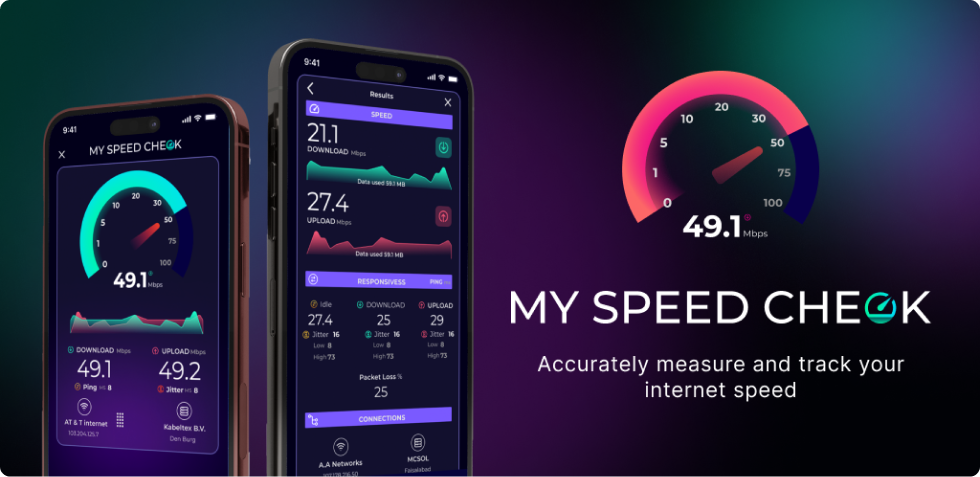-
AT&T Speed Test
AT&T (ATT) is one of the giants in the networking scene. It is a tier-1 ISP and provides Fiber, DSL, and Fixed Wireless services across the US. However, even though it is so big, depending on where you live, you may only have access to some of the services.
Since all three use different media to provide internet access, they come with their own quirks and drawbacks. The ATT speed test lets you check whether these quirks are affecting you too much (or not) by showing your current speed, ping, and jitter.
Why AT&T Users Should Run Speed Tests
ATT customers should do speed tests to understand and diagnose problems they may have with their connection. Some of the common problems that customers can run into are given below.
- AT&T Fiber can hit 1–5 Gbps, but Wi-Fi router limits, or older cables in your house/office, may not let you experience it fully.
- Older DSL plans may deliver much lower speeds than advertised.
- Even if speeds are high, ping and jitter can mar the experience. Speed tests show how good or bad they are.
- AT&T often uses combo modem-router gateways, which can bottleneck new gigabit plans
With the ATT Speed Test, you can confirm if any network disruptions or slowdowns are due to your device, your router, or the ISP. That’s why ATT users should do speed tests somewhat regularly.
Fiber, DSL, or Wireless: Speed Ranges for Each
Depending on which type of internet access you receive from AT&T, you will experience different speeds. Here are the typical speeds you can get from AT&T, depending on your subscribed package and medium.
AT&T Fiber offers speeds ranging from 300 Mbps up to 5 Gbps, depending on the plan. In fiber plans, the speeds are most affected by the type of router, WiFi standard (4,5,6, 6e,7), and type of cable (cat5, cat6) you use.
AT&T Internet (DSL) typically delivers speeds between 10 and 100 Mbps. DSL speeds are considerably affected by things like:
- the distance from the service node,
- the quality of the copper lines,
- and how many users share the same node.
AT&T Fixed Wireless provides speeds in the 25–100 Mbps range. Since fixed wireless uses radio signals for last-mile delivery, its performance is affected due to signal strength, weather conditions, and tower load.
Lastly, AT&T Hotspot or 5G connections can reach speeds from 20 Mbps to over 400 Mbps. Just like fixed wireless, the speeds depend heavily on signal strength and network congestion/tower load.
How the AT&T Speed Test Works
To start your ATT speed test, simply click/tap the “Go” button on the web page. This will start the test, and your connection stats will be measured against a test server. Normally, the server is selected automatically, but you can manually change it too by clicking/tapping on its name before starting the test.
The tool measures:
- Download speed which is a measure of how fast you can receive data.
- Upload speed, which is a measure of how fast you can send data.
- Ping is a measure of response time between you and the server.
- Jitter is a measure of how stable your latency is over time.
These results help you figure out the cause of slow speeds.
What Speeds You Should Expect
Now, ISPs like to tell you the best possible speeds available in your package, but they are not what you get most of the time due to various reasons.
AT&T 300 Mbps Fiber:
- Wired: 280–300 Mbps
- Wi-Fi: 150–250 Mbps
AT&T 1 Gbps Fiber:
- Wired: 900–950 Mbps
- Wi-Fi: 400–800 Mbps (Wi-Fi 6)
DSL 50 Mbps:
- Wired: 40–50 Mbps
- Wi-Fi: 20–40 Mbps
Fixed Wireless:
- Wired: 25–100 Mbps
- Wi-Fi: Same range, depending on signal quality
How to Improve Slow AT&T Speeds
To fix possible issues on your end that can cause slow speeds, you can try the following tips.
- If you're on Fiber, use a wired (Ethernet) test first. It is common for Wi-Fi to be the bottleneck.
- Upgrade to a Wi-Fi 6E or WiFi 7 router if you’re still using the AT&T gateway alone.
- For DSL, static speed issues may require a line quality check. Do that to ensure your cable is not the problem.
- For wireless plans, speed can improve by repositioning your router or using an external antenna.
- If only uploads are slow, check for cloud sync apps (iCloud, OneDrive, Dropbox, etc.) When they are running in the background, they eat up available bandwidth and slow down your uploads.
Frequently Asked Questions
Does this AT&T speed test work for both AT&T Fiber and DSL?
Yes, the ATT speed test is ubiquitous and will show results for any type of ATT internet connection.
Why is my AT&T Internet speed low on Wi-Fi?
If your WiFi device is running an old standard, then it cannot output gigabit or high megabit speeds. However, Ethernet Cat 6 cables (commonly available) can. So, your WiFi device might be outdated.
Can I use this ATT internet speed test for my AT&T hotspot or 5G phone?
Yes, this att internet speed test works on all internet-capable devices with browsers and can test the speed of any internet connection.
Why is my DSL speed different from what AT&T advertises?
DSL speed depends on the distance from the nearest node. The farther you are, the slower it becomes. So, if your node is too far, your speed will be slower than advertised.
